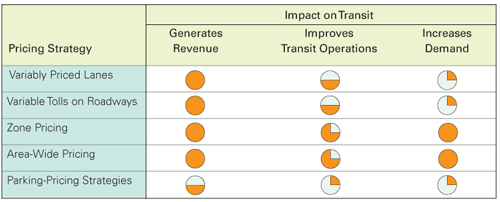Transit and Congestion Pricing
Summary
The table below summarizes the magnitude of the potential impacts that various types of congestion pricing may have on transit revenues, transit operations, and transit ridership. Key lessons learned from U.S. and international experiences with congestion pricing are summarized as follows:
- Corridor-pricing strategies in the United States have shown that the active involvement of transit agencies is not required to be successful. International cordon-pricing experiments, however, could not have been successful without the involvement of transit.
- Transit involvement in domestic value-pricing strategies has been limited. Upper management at both highway and transit agencies must commit to jointly developing a congestion-pricing program. Experience suggests that without an active transit role, projects are likely to revert to a highway initiative.
- All congestion-pricing schemes deployed in the United States to date have had the primary goal of congestion reduction (via modifications to travel times and routes) followed by revenue enhancements. Most areas have barely acknowledged mode shift as a goal and then usually only as a byproduct of pricing initiatives.
- Express buses and BRT are the primary transit modes involved with, and benefiting from, HOV or HOT lanes and other corridor-pricing strategies, compared with the multiple transit modes (e.g., bus, rail, BRT, carpools, or vanpools) that must be involved with zone-pricing strategies.
- Congested areas may need to set their congestion-pricing fees relatively high to achieve the desired level of service on the roadways. Tolls on Orange County’s SR-91 have progressively risen (to as much as $0.95 per mile) to maintain free-flowing traffic; however, higher fees do not lead to significant modal shifts in the absence of a reliable and viable transit alternative.
- Insufficient development of park-and-ride facilities has greatly limited transit’s involvement in the domestic-pricing deployments. If mode shift is a project goal, properly sited parking must be developed to accommodate increased transit demand.
 Table. Potential impacts congestion pricing may have on transit. There are four columns. The stubhead is “Pricing Strategy, and ” “Impact on Transit” spans the three other column heads: “Generates Revenue,” “Improves Transit Operations,” and “Increases Demand.” There are five rows under “Pricing Strategy”: “Variably Priced Lanes,” “Variable Tolls on Roadways,” “Zone Pricing,” “Area-Wide Pricing,” and Parking-Pricing Strategies.” Filled-in circles are used to illustrate how effectively the pricing strategy generates revenue, improves transit operations, and increases demand. Variably priced lanes fills 100% of the circle for generates revenue, 50% for improves transit operations, and 25% for increases demand. Variable tolls on roadways fills 100% for generates revenue, 50% for improves transit operations, and 25% for increases demand. Zone pricing fills 100% for generates revenue, 75% of improves transit operations, and 100%for increases demand. Area-wide pricing fills 100% for generates revenue, 75% for improves transit operations, and 100% for increases demand. Parking-pricing strategies fills 50% for generates revenue, 25% for improves transit operations, and 25% for increases demand.
Table. Potential impacts congestion pricing may have on transit. There are four columns. The stubhead is “Pricing Strategy, and ” “Impact on Transit” spans the three other column heads: “Generates Revenue,” “Improves Transit Operations,” and “Increases Demand.” There are five rows under “Pricing Strategy”: “Variably Priced Lanes,” “Variable Tolls on Roadways,” “Zone Pricing,” “Area-Wide Pricing,” and Parking-Pricing Strategies.” Filled-in circles are used to illustrate how effectively the pricing strategy generates revenue, improves transit operations, and increases demand. Variably priced lanes fills 100% of the circle for generates revenue, 50% for improves transit operations, and 25% for increases demand. Variable tolls on roadways fills 100% for generates revenue, 50% for improves transit operations, and 25% for increases demand. Zone pricing fills 100% for generates revenue, 75% of improves transit operations, and 100%for increases demand. Area-wide pricing fills 100% for generates revenue, 75% for improves transit operations, and 100% for increases demand. Parking-pricing strategies fills 50% for generates revenue, 25% for improves transit operations, and 25% for increases demand.
Potential impacts congestion pricing may have on transit.
|